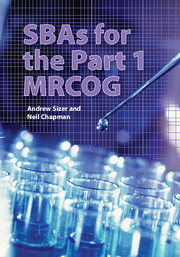Book contents
- Frontmatter
- Contents
- Preface
- About the authors
- Acknowledgements
- Abbreviations
- Foreword
- How to use this book
- 1 Structure and content of the Part 1 MRCOG examination
- 2 Part 1 MRCOG blueprinting matrix, syllabus topics and example questions for paper 1
- 3 Part 1 MRCOG blueprinting matrix, syllabus topics and example questions for paper 2
- 4 Mock paper: paper 1
- 5 Mock paper: paper 2
- Appendix 1 Blueprinting matrix for the Part 1 MRCOG examination
- Appendix 2 Example SBA answer sheet
- Appendix 3 Answers to chapter 2 questions
- Appendix 4 Answers to chapter 3 questions
- Appendix 5 Answers to mock paper 1 (chapter 4)
- Appendix 6 Answers to mock paper 2 (chapter 5)
5 - Mock paper: paper 2
Published online by Cambridge University Press: 05 July 2014
- Frontmatter
- Contents
- Preface
- About the authors
- Acknowledgements
- Abbreviations
- Foreword
- How to use this book
- 1 Structure and content of the Part 1 MRCOG examination
- 2 Part 1 MRCOG blueprinting matrix, syllabus topics and example questions for paper 1
- 3 Part 1 MRCOG blueprinting matrix, syllabus topics and example questions for paper 2
- 4 Mock paper: paper 1
- 5 Mock paper: paper 2
- Appendix 1 Blueprinting matrix for the Part 1 MRCOG examination
- Appendix 2 Example SBA answer sheet
- Appendix 3 Answers to chapter 2 questions
- Appendix 4 Answers to chapter 3 questions
- Appendix 5 Answers to mock paper 1 (chapter 4)
- Appendix 6 Answers to mock paper 2 (chapter 5)
Summary
Answers to the questions in this chapter can be found in appendix 6.
1 What is the principle of DEXA scanning to assess bone mineral density?
A The absorption of a single high-dose X-ray beam is measured at two different angles
B The absorption of a single low-dose beam is measured at multiple intervals and analysed by a computer
C The absorption of a single low-dose X-ray beam is measured at two different angles
D Two high-dose X-ray beams are emitted and the absorption of the sof-tissue beam is subtracted from the total beam
E Two low-dose X-ray beams are emitted and the absorption of the soft-tissue beam is subtracted from the total beam
2 In radiotherapy, what is the SI unit of absorbed radiation dose?
A Curie
B Gray
C Joule
D Rad
E Sievert
3 What is the best description of the Doppler effect?
A A stationary target absorbs more ultrasound than a moving target
B A stationary target reflects more ultrasound than a moving target
C The frequency of a transmitted and reflected ultrasound wave are always constant
D The ultrasound wave reflected from a moving target has a different frequency from the transmitted wave
E The ultrasound wave reflected from a moving target has the same frequency as the transmitted wave
- Type
- Chapter
- Information
- SBAs for the Part 1 MRCOG , pp. 91 - 110Publisher: Cambridge University PressPrint publication year: 2012



